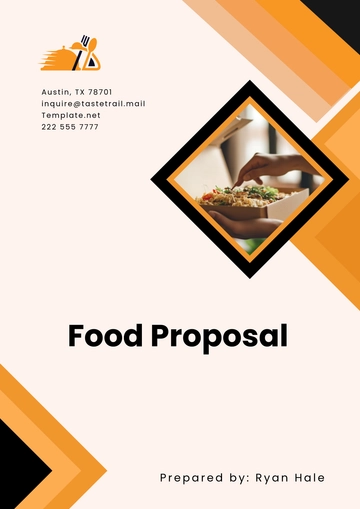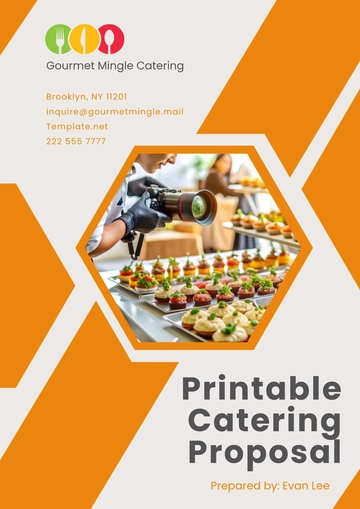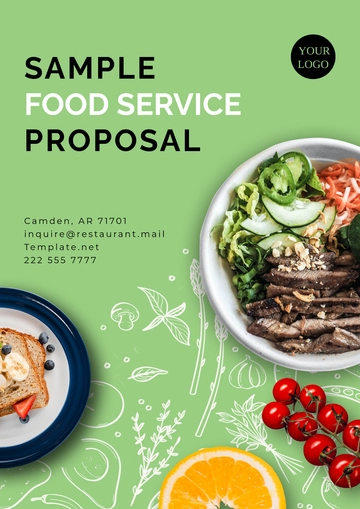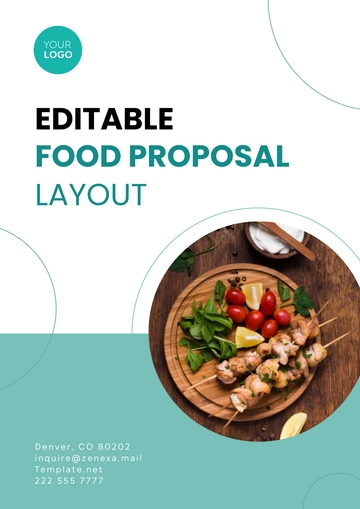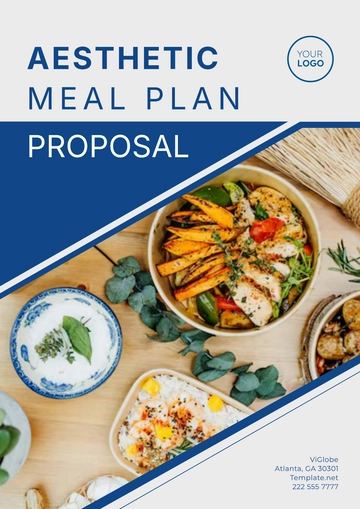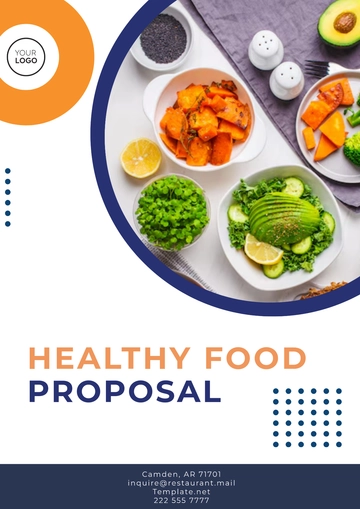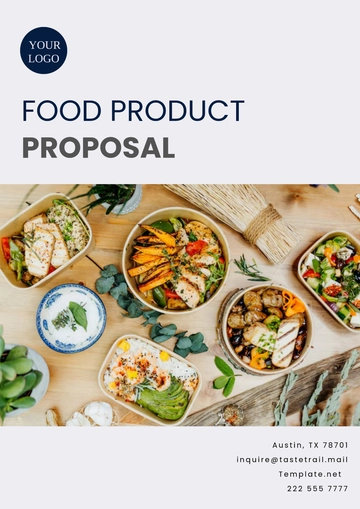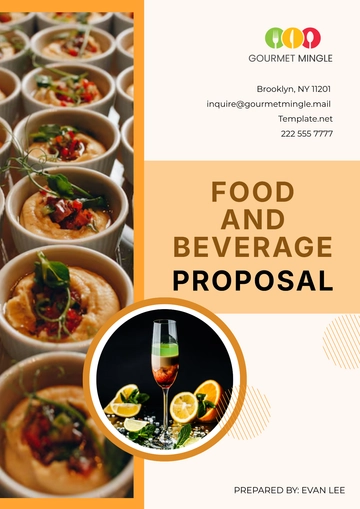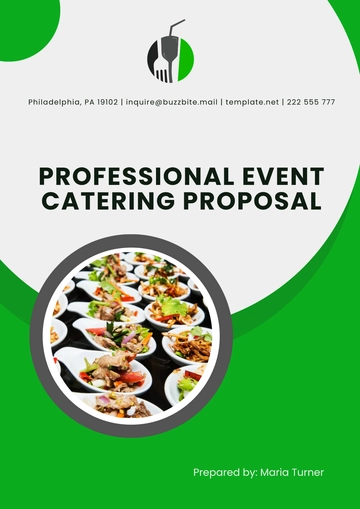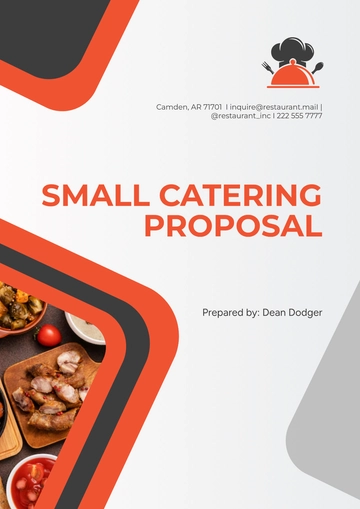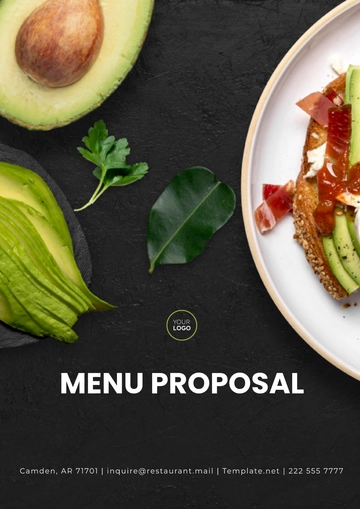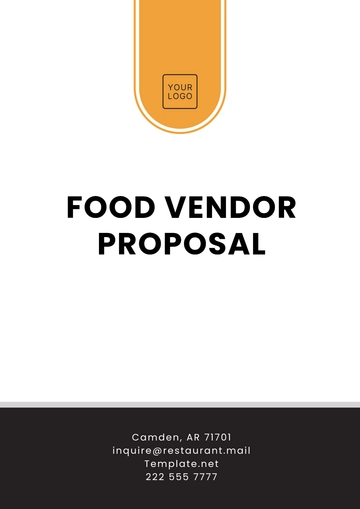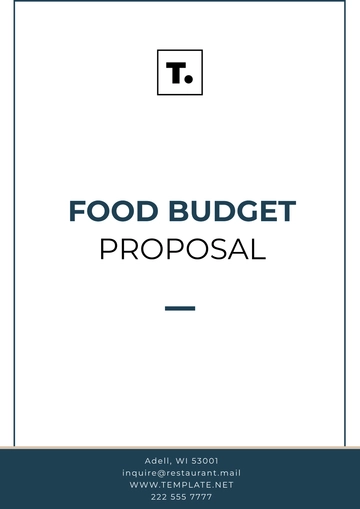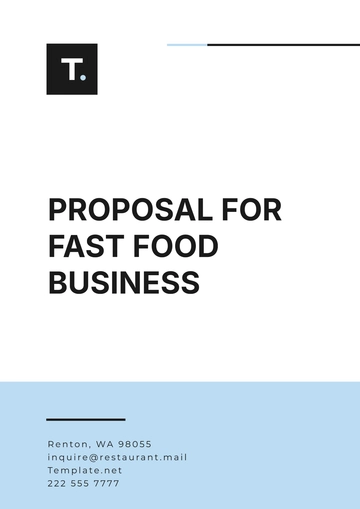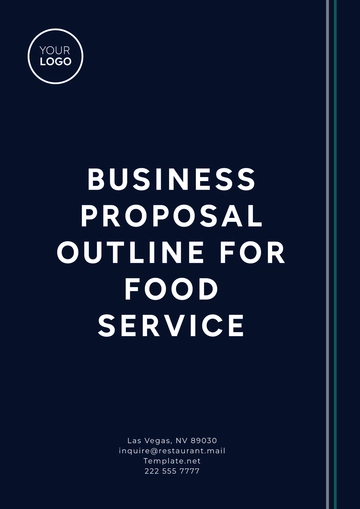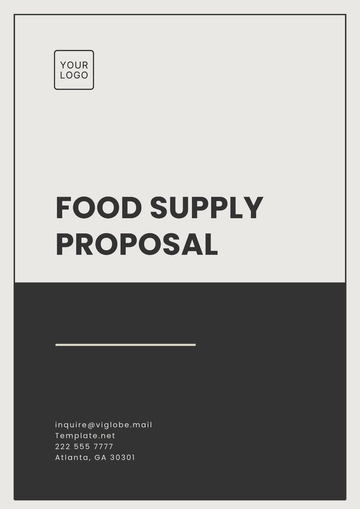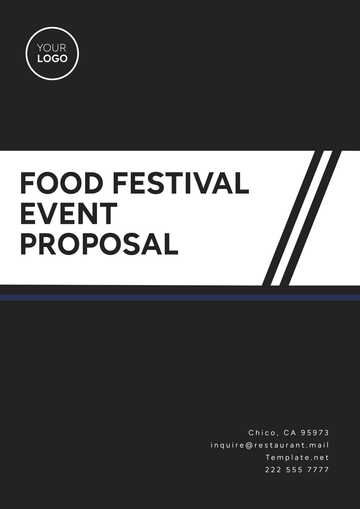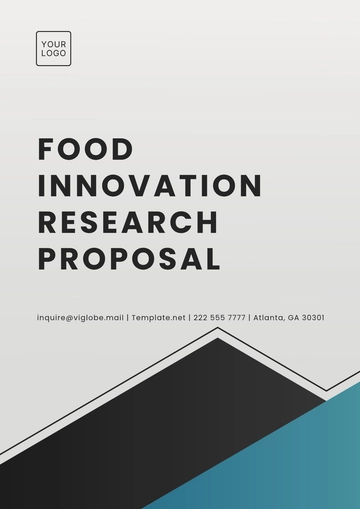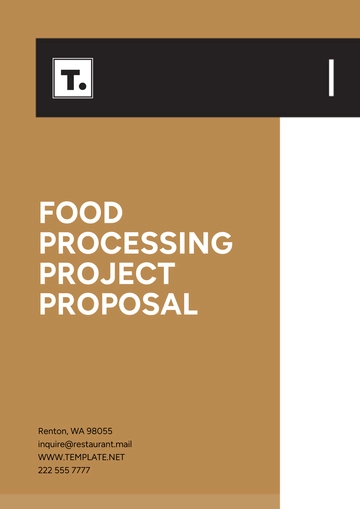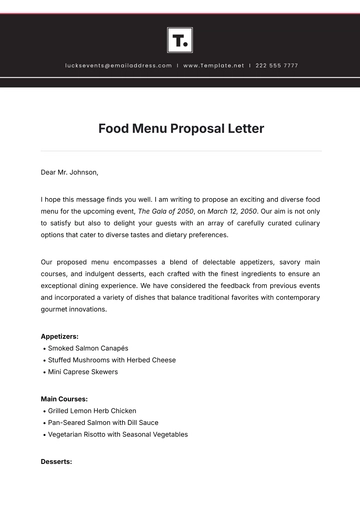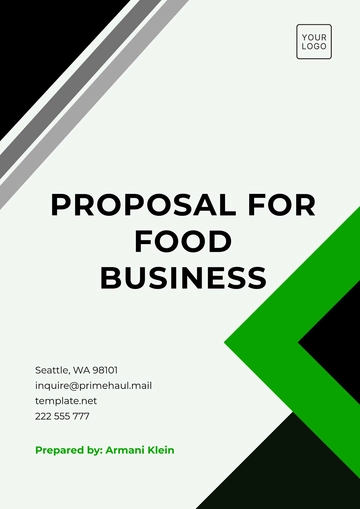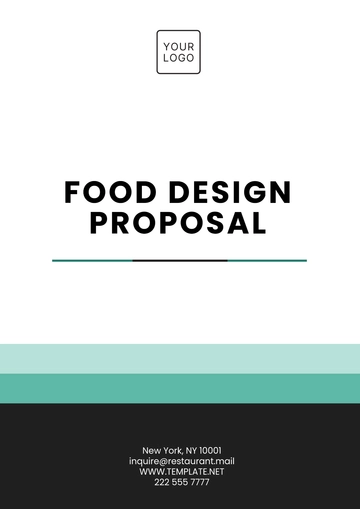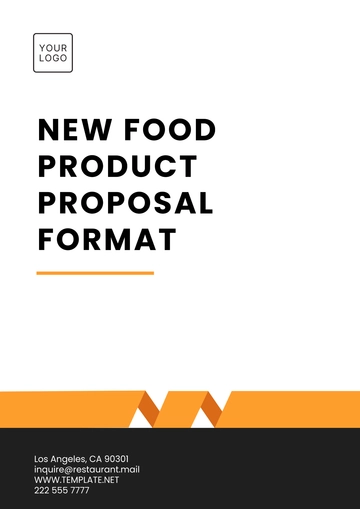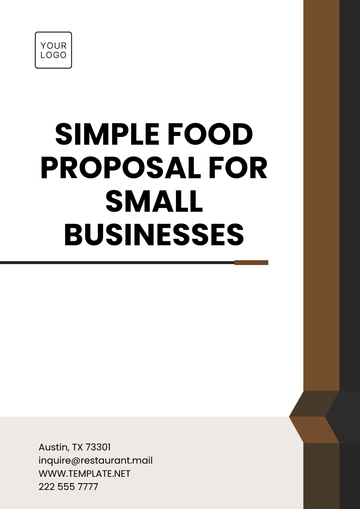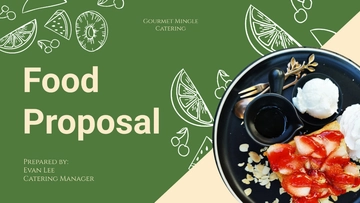Free Food Truck Business Proposal

I. Executive Summary
A. Overview
[Your Company Name] aims to launch a premium food truck business that specializes in gourmet street food infused with international flavors. As we look towards 2050, our goal is to redefine the concept of street dining by combining convenience, quality, and sustainability into a single mobile platform. We recognize the growing demand for unique culinary experiences that cater to the busy lifestyles of urban dwellers. Our food truck will not only serve as a mobile kitchen but also as a space where community and culture converge over food.
Our vision is to combine convenience with culinary excellence, targeting busy professionals, students, and food enthusiasts who seek high-quality meals on the go. This proposal outlines our business plan, encompassing menu development, operational strategies, and financial forecasts, all aimed at establishing a sustainable and profitable business model that can adapt to changing market demands.
B. Vision and Mission
Vision: To become a leading food truck brand, recognized for gourmet, sustainable, and convenient street food in major urban centers by 2060. We aspire to be the go-to choice for anyone looking for a quick yet delightful meal that doesn’t compromise on taste or quality.
Mission: To serve high-quality, globally-inspired street food that delights customers while operating with sustainable and eco-friendly business practices. Our mission encompasses not only serving delicious food but also educating our customers on the importance of sustainability in the food industry.
C. Key Financial Highlights
Start-up Capital: Estimated at [$150,000] for the first year, which will cover all initial expenses and ensure a smooth launch.
Revenue Projections: Expected annual revenue of [$500,000] by the end of year 1, with a growth rate of [15%] annually for the next five years as we expand our customer base and refine our operations.
Profit Margin: A projected profit margin of [20%] by the end of year 3, achieved through careful cost management and strategic pricing.
Break-even Point: Anticipated to occur within [18 months] of operation, demonstrating the potential for rapid growth and sustainability in the food truck market.
II. Company Profile
A. Business Name and Structure
Business Name: [Your Company Name]
Business Structure: Limited Liability Company (LLC), which provides personal liability protection for owners while allowing flexibility in management and tax benefits. This structure will also help us build credibility and establish partnerships with vendors and suppliers more effectively.
B. Location and Target Market
The food truck will primarily operate in urban areas such as bustling business districts, vibrant college campuses, and popular event venues across major cities. The mobile nature of the business allows [Your Company Name] to cater to a diverse demographic, including:
Busy professionals: These individuals often seek quick yet satisfying meals during their limited lunch breaks, making them ideal customers for our gourmet offerings.
College students: A large and vibrant market segment that values affordability and diverse food options, with a penchant for trying new flavors and culinary experiences.
Event-goers: Attendees of festivals, concerts, and pop-up events who are looking for high-quality street food to enjoy while socializing with friends and family.
By strategically selecting high-footfall locations, we can maximize our visibility and attract a wide range of customers, ensuring that our food truck becomes a local favorite.
C. Business Goals and Objectives
1. Short-Term Goals
Successfully launch the food truck by mid-2050, ensuring all operations, permits, and marketing campaigns are in place for a grand opening.
Build a loyal customer base within the first [6 months] of operation by implementing effective marketing strategies and delivering exceptional customer service.
Achieve break-even within [18 months], allowing us to reinvest profits into the business for growth and expansion.
2. Long-Term Goals
Expand to [3] additional trucks in neighboring cities by 2055, increasing brand recognition and market share.
Implement a franchise model by 2060 to further scale the business, allowing others to replicate our successful concept while maintaining quality and sustainability standards.
III. Products and Services
A. Menu Offerings
[Your Company Name] will offer a fusion menu, combining globally-inspired flavors with local, organic ingredients to create a dining experience that excites the palate. Our carefully curated menu will include a rotating selection of gourmet sandwiches, tacos, salads, and bowls, all designed to be served quickly without compromising on quality.
Menu
Korean BBQ Tacos: Soft, warm tacos filled with marinated beef, pickled vegetables, and a spicy gochujang sauce. This dish offers a perfect balance of flavors and textures, making it a favorite among customers seeking something adventurous yet comforting.
Mediterranean Falafel Bowl: A healthy, plant-based option featuring homemade falafel, creamy hummus, fresh tabbouleh, and warm pita bread. This bowl not only satisfies hunger but also appeals to health-conscious consumers.
Truffle Parmesan Fries: Hand-cut fries tossed in truffle oil and grated parmesan for a gourmet twist on a classic side dish. This indulgent offering will attract customers looking for a unique and flavorful snack.
B. Seasonal and Special Menus
We will introduce limited-time seasonal menus to keep the offerings fresh and exciting, particularly during local events and holidays. This will include:
Summer Specials: Light, refreshing options like ceviche bowls and tropical fruit salads that capture the essence of summer dining. These dishes will not only be delicious but also visually appealing, making them ideal for social media sharing.
Winter Comforts: Hearty soups and warm sandwiches made with seasonal produce to provide comfort during the colder months. We will also consider partnerships with local farms to source ingredients that reflect the season's best offerings.
C. Unique Selling Proposition (USP)
Sustainability: All packaging will be compostable, reducing our environmental footprint and appealing to eco-conscious consumers. Our commitment to sustainability will be a cornerstone of our brand identity.
Locally Sourced Ingredients: We will partner with local farms to ensure the freshest ingredients, thus supporting the local economy and minimizing our carbon footprint. This focus on local sourcing will enhance the quality of our dishes and create a strong connection with our community.
Speed and Convenience: The menu will be crafted for quick service, ensuring that customers get high-quality meals without long waits. Our food truck will be designed for efficiency, allowing us to serve customers promptly during peak hours.
IV. Market Analysis
A. Industry Overview
The food truck industry has grown exponentially in recent decades, with a projected market value of [$5 billion] in 2050. This growth is driven by the increasing demand for convenient, affordable, and diverse dining options in urban areas. Food trucks offer lower overhead compared to traditional brick-and-mortar restaurants, making them an attractive business model in the competitive food service industry. Additionally, the rise of food tourism and the desire for unique culinary experiences have further fueled this industry's expansion.
B. Target Market Demographics
Age Group: Primarily [18–45] years old, a demographic that actively seeks out diverse food options and values convenience.
Income Range: Annual income between [$30,000] and [$100,000], reflecting a broad spectrum of potential customers who can afford gourmet meals on-the-go.
Preferences: Health-conscious, adventurous eaters who value sustainability and convenience, and are often influenced by social media trends.
By identifying and targeting these specific demographics, we can tailor our marketing efforts and menu offerings to meet their unique preferences and needs.
C. Competitive Analysis
The food truck market is highly competitive, with numerous operators offering similar products. However, [Your Company Name] differentiates itself through its commitment to sustainability, the use of local ingredients, and a diverse selection of international flavors.
Key Competitors
[Competitor 1]: Specializes in gourmet burgers and has a large social media following, making it a popular choice among young professionals.
[Competitor 2]: Focuses on vegan options and has a strong local presence near college campuses, appealing to health-conscious students.
While these competitors have established themselves within the market, [Your Company Name] aims to carve out its niche by delivering exceptional culinary experiences and emphasizing eco-friendly practices.
D. SWOT Analysis
Strengths | Weaknesses |
|---|---|
Unique, diverse menu | Limited initial visibility |
Strong commitment to sustainability | Dependence on weather conditions for sales |
Experienced management team | High operational costs |
Opportunities | Threats |
|---|---|
Expanding food truck market | Increased competition |
Growing demand for gourmet food | Economic downturns affecting discretionary spending |
Potential for franchising | Regulatory challenges |
This SWOT analysis allows us to strategically address potential challenges while capitalizing on our strengths and opportunities.
V. Marketing and Sales Strategy
A. Branding and Positioning
1. Brand Identity
[Your Company Name] will create a strong brand identity that resonates with our target audience. Our branding will focus on elements such as quality, sustainability, and global culinary experiences. This will be communicated through our logo, truck design, and promotional materials, ensuring a cohesive and appealing image.
2. Positioning Statement
"We are the food truck that brings the world to your plate, offering gourmet, sustainable meals made from the freshest local ingredients, served with speed and flair." This statement emphasizes our commitment to quality and sustainability while appealing to the adventurous spirit of our customers.
B. Pricing Strategy
Pricing will be competitive yet reflective of the gourmet nature of our offerings. We will implement a tiered pricing strategy based on ingredient quality, preparation complexity, and portion size. The average meal price will range from [$10] to [$15], allowing us to maintain quality while remaining accessible to our target market.
C. Promotional Campaigns
To create buzz and attract customers, we will implement the following promotional strategies:
Social Media Marketing: Engaging content showcasing our dishes, sustainability practices, and behind-the-scenes operations on platforms like Instagram, TikTok, and Facebook. Regular posts will keep our audience informed and engaged, creating anticipation for new menu items and special events.
Loyalty Programs: Offering discounts or free items after a certain number of purchases to encourage repeat business. This strategy not only builds customer loyalty but also helps us collect valuable data on customer preferences and buying habits.
Local Events and Festivals: Participating in community events, food festivals, and farmers' markets to enhance visibility and create direct connections with potential customers. These events will serve as an opportunity to showcase our menu and gather feedback.
D. Sales Channels
The primary sales channel will be the food truck itself, operating at high-traffic locations and events. In addition, we will explore partnerships with local businesses to offer catering services for private events and corporate functions. This will not only generate additional revenue but also promote brand awareness among a wider audience.
VI. Operational Plan
A. Food Truck Design and Equipment
The food truck will be equipped with state-of-the-art kitchen equipment, ensuring that all food is prepared efficiently and to the highest standards. Key equipment will include:
Commercial-grade grill and fryer: For quick cooking of meats and sides.
Refrigeration units: To keep ingredients fresh and comply with health regulations.
Prep stations: Designed for efficient food assembly and minimizing wait times.
1. Truck Design
The truck's exterior will feature eye-catching graphics that reflect our brand identity, including our logo and vibrant images of our dishes. The design will not only attract customers but also serve as a mobile advertisement for our brand.
B. Supply Chain and Vendor Relationships
Establishing strong relationships with local suppliers will be crucial for maintaining the quality and sustainability of our ingredients. We will focus on:
Local farms: Partnering with organic farms to source fresh produce and meats.
Sustainable packaging suppliers: Utilizing compostable and biodegradable materials to align with our commitment to sustainability.
Regular evaluations of vendor performance will ensure we maintain the quality and reliability of our supply chain.
C. Staffing and Training
A skilled and motivated team will be essential for delivering exceptional service. We will hire a team of [4-6] employees, including:
Food truck operators: Responsible for food preparation and customer service.
Cooks: Trained in gourmet cooking techniques to maintain the quality of our dishes.
Marketing and Sales personnel: Focused on promoting the food truck and engaging with customers online and offline.
1. Training Programs
Comprehensive training will cover food safety, customer service, and the unique aspects of our menu. Ongoing training will ensure our team remains knowledgeable about new menu items and sustainability practices.
D. Daily Operations and Customer Experience
The food truck will operate from [10:00 AM to 8:00 PM], focusing on both lunch and dinner service. Key operational strategies will include:
Order Management: Implementing a digital ordering system through a mobile app to allow customers to place orders in advance. This will minimize wait times and improve overall customer satisfaction.
Quality Control: Regular checks to ensure food quality and presentation meet our high standards. This attention to detail will help us build a strong reputation and encourage repeat business.
1. Customer Engagement
We will actively engage with customers through social media, encouraging them to share their experiences and feedback. This two-way communication will foster a sense of community and loyalty among our customer base.
VII. Financial Plan
A. Start-up Costs
Expense Category | Estimated Cost ($) |
|---|---|
Food Truck Purchase | [75,000] |
Kitchen Equipment | [20,000] |
Initial Inventory | [10,000] |
Branding and Marketing | [10,000] |
Licensing and Permits | [5,000] |
Working Capital | [30,000] |
Total Start-up Costs | [150,000] |
1. Detailed Breakdown of Costs
Food Truck Purchase: This includes the cost of purchasing a new or gently used food truck, as well as any necessary retrofitting for kitchen equipment.
Kitchen Equipment: High-quality, commercial-grade equipment is essential for efficiency and compliance with health standards.
Initial Inventory: A well-stocked inventory of ingredients and supplies is crucial for a successful launch.
Branding and Marketing: This encompasses the costs for logo design, truck graphics, website development, and initial promotional campaigns.
Licensing and Permits: Securing necessary permits and licenses to operate legally within our chosen locations is essential.
Working Capital: This will cover operational costs such as wages, utilities, and ongoing supply purchases during the initial months of operation.
B. Revenue Projections
Revenue projections are based on estimated sales volume and average meal pricing. Our initial projections are as follows:
Year 1: Projected revenue of [$500,000] based on an average of [100] meals sold per day at an average price of [$10] per meal.
Year 2: Projected revenue of [$575,000], reflecting a [15%] growth rate due to increased customer awareness and brand loyalty.
Year 3: Projected revenue of [$661,250], as we expand our customer base and potentially add additional menu items.
1. Factors Influencing Revenue
Location: Operating in high-footfall areas will significantly impact sales volume.
Menu Diversity: Seasonal specials and unique items attract repeat customers.
Promotional Effectiveness: Successful marketing campaigns and community engagement will drive sales.
C. Profit and Loss Forecast
By the end of year 1, we expect a net profit of [$50,000] after accounting for operational expenses and the cost of goods sold (COGS).
1. Expense Breakdown
Monthly Operating Costs: Estimated at [$30,000], which includes salaries, ingredient costs, and truck maintenance.
COGS: Expected to be approximately [30%] of sales, reflecting our commitment to using high-quality, sustainable ingredients.
Profit margins will steadily increase as the business scales and fixed costs are spread across a larger revenue base, creating an opportunity for reinvestment into the business.
D. Break-Even Analysis
We anticipate breaking even within the first [18 months] of operation, assuming an average monthly revenue of [$41,667] and monthly fixed costs of approximately [$30,000].
E. Funding Requirements
To cover the initial start-up costs, we seek funding of [$150,000] through a combination of personal investment, small business loans, and potential investors.
1. Investor Returns
In exchange for an equity stake in the business, investors can expect a [20%] return on investment within [5 years], driven by the projected growth in revenue and profitability. This attractive return, combined with a solid business model, will appeal to potential investors looking for opportunities in the food industry.
VIII. Conclusion
A. Summary of Business Proposal
[Your Company Name] presents a promising opportunity in the thriving food truck industry. By offering high-quality, globally-inspired cuisine with a commitment to sustainability, we are positioned to build a loyal customer base and achieve long-term profitability. Our detailed operational and marketing plans, coupled with realistic financial projections, demonstrate our readiness to embark on this exciting venture.
B. Future Growth and Expansion Plan
As we successfully establish our initial location, our focus will shift toward expansion and scalability. By the end of [2055], we aim to have [3] food trucks operating in different cities, and by [2060], we will explore franchising opportunities to share our successful business model with aspiring entrepreneurs. This strategic growth will ensure that [Your Company Name] remains a leader in the gourmet food truck market, continually evolving to meet the demands of our customers and the food industry.
- 100% Customizable, free editor
- Access 1 Million+ Templates, photo’s & graphics
- Download or share as a template
- Click and replace photos, graphics, text, backgrounds
- Resize, crop, AI write & more
- Access advanced editor
Present your food truck concept with confidence using the Food Truck Business Proposal Template from Template.net. This editable and customizable template helps you outline your vision, market analysis, and financial forecasts clearly. Tailor it in our Ai Editor Tool to captivate potential investors and partners.
You may also like
- Business Proposal
- Research Proposal
- Proposal Request
- Project Proposal
- Grant Proposal
- Photography Proposal
- Job Proposal
- Budget Proposal
- Marketing Proposal
- Branding Proposal
- Advertising Proposal
- Sales Proposal
- Startup Proposal
- Event Proposal
- Creative Proposal
- Restaurant Proposal
- Blank Proposal
- One Page Proposal
- Proposal Report
- IT Proposal
- Non Profit Proposal
- Training Proposal
- Construction Proposal
- School Proposal
- Cleaning Proposal
- Contract Proposal
- HR Proposal
- Travel Agency Proposal
- Small Business Proposal
- Investment Proposal
- Bid Proposal
- Retail Business Proposal
- Sponsorship Proposal
- Academic Proposal
- Partnership Proposal
- Work Proposal
- Agency Proposal
- University Proposal
- Accounting Proposal
- Real Estate Proposal
- Hotel Proposal
- Product Proposal
- Advertising Agency Proposal
- Development Proposal
- Loan Proposal
- Website Proposal
- Nursing Home Proposal
- Financial Proposal
- Salon Proposal
- Freelancer Proposal
- Funding Proposal
- Work from Home Proposal
- Company Proposal
- Consulting Proposal
- Educational Proposal
- Construction Bid Proposal
- Interior Design Proposal
- New Product Proposal
- Sports Proposal
- Corporate Proposal
- Food Proposal
- Property Proposal
- Maintenance Proposal
- Purchase Proposal
- Rental Proposal
- Recruitment Proposal
- Social Media Proposal
- Travel Proposal
- Trip Proposal
- Software Proposal
- Conference Proposal
- Graphic Design Proposal
- Law Firm Proposal
- Medical Proposal
- Music Proposal
- Pricing Proposal
- SEO Proposal
- Strategy Proposal
- Technical Proposal
- Coaching Proposal
- Ecommerce Proposal
- Fundraising Proposal
- Landscaping Proposal
- Charity Proposal
- Contractor Proposal
- Exhibition Proposal
- Art Proposal
- Mobile Proposal
- Equipment Proposal
- Student Proposal
- Engineering Proposal
- Business Proposal
